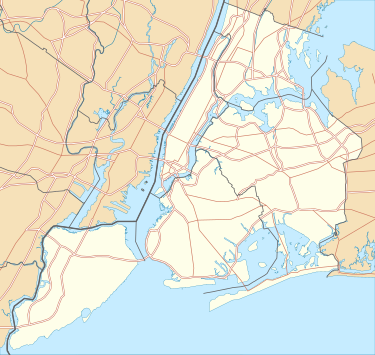Throgs Neck Bridge
| Throgs Neck Bridge | |
|---|---|
 Aerial view of the Throgs Neck Bridge (above the Bronx). | |
| Carries | 6 lanes of |
| Crosses | East River |
| Locale | New York City (Throggs Neck, Bronx – Bay Terrace, Queens) |
| Maintained by | MTA Bridges and Tunnels |
| Design | Suspension bridge |
| Total length | 2,910 feet (890 m) |
| Longest span | 1,800 feet (550 m) |
| Clearance below | 142 feet (43 m) |
| Opened | January 11, 1961 (1961-01-11)[1] |
| Toll | $7.50 (cash); $5.33 (New York State E-ZPass) |
| Daily traffic | 108,455 (2010)[2] |
| Coordinates | 40°48′06″N 73°47′36″W / 40.80167°N 73.79333°W / 40.80167; -73.79333Coordinates: 40°48′06″N 73°47′36″W / 40.80167°N 73.79333°W / 40.80167; -73.79333 |
The Throgs Neck Bridge is a suspension bridge opened on January 11, 1961, which carries Interstate 295 over the East River where it meets Long Island Sound. The bridge connects the Throggs Neck section of the Bronx with the Bay Terrace section of Queens. It is the newest bridge across the East River and was built to relieve traffic on the adjacent Whitestone Bridge which opened in 1939.
The Throgs Neck Bridge is the easternmost bridge off of Long Island. Due to this and its proximity to both the Cross Bronx Expressway and the New England Thruway, it is the preferred route from Long Island to New Jersey via the George Washington Bridge, upstate New York, Connecticut and other points north and east. Heading northbound, there are views of the Trump Towers in New Rochelle, Westchester County, and heading southbound on a clear day, one can see the Manhattan skyline.
History[edit]
The Throgs Neck Bridge was planned and managed by Robert Moses. His first plan for a Throgs Neck span dates back to 1945, six years after his previous project, the Bronx–Whitestone Bridge, was completed 2 miles (3 km) to the west. This bridge was one of the few not intended for the Belt System of highways wrapping around Queens and Brooklyn. Moses commissioned famed New York City bridge designer Othmar Ammann. Ammann was the man behind the George Washington, Bronx-Whitestone, Verrazano-Narrows, and Triborough bridges. This was Ammann's first long-span job after 1940, which saw the collapse of the original Tacoma Narrows Suspension Bridge in the state of Washington. Instead of employing a rather streamlined-looking plate-girder system, Ammann constructed his bridge with 28-foot-deep (8.5 m) stiffening trusses under the deck. These would weight the bridge and allow any wind to simply blow through, instead of against, the bridge.
Ammann designed the bridge with long, curved approaches (increasing the length of the roadway) in order to allow for water traffic beneath the span. The shores of Bay Terrace and Throggs Neck are rather low, so to build a bridge right over the water without approaches would leave almost no clearance under the bridge. Deck-raising began at each tower until crews met at the center, extending out to the approach viaducts.
The span is 1,800 feet (549 m) long, with an anchorage to anchorage total length of 2,910 feet (887 m). The bridge was designed without non-motorized access of any kind. There are also no regularly scheduled buses.
During planning, the bridge received the I-495 designation. During construction, the bridge became a part of I-78. Not until 1971 did the Throgs Neck Bridge become a part of I-295.
Late in the 20th century the area underneath the Queens approaches became Little Bay Park.
On Friday, July 10, 2009 at about 5:00 a.m., a construction worker's blow torch sparked a three-alarm fire on the bridge during maintenance work to replace the deck.[3][4] The fire closed the bridge for much of the day, sending traffic in both directions to the nearby Whitestone Bridge. Approximately 140 firefighters were needed to put out the fire, which lasted at least seven hours, and was fought from the scaffolding below the deck and from boats on the water.[5] Traffic lanes on the Queens-bound side of the bridge reopened in the afternoon before the evening rush hour, but only two Bronx-bound lanes were reopened later in the evening.[6] The third lane remained closed due to repair work for exactly a month when it reopened on August 10.[7]
On January 11, 2011, the Throgs Neck Bridge celebrated its fiftieth year of operation.[8]
The Throgs Neck Bridge is owned by the City of New York[citation needed] and operated by the Triborough Bridge and Tunnel Authority, an affiliate agency of the MTA.
Unlike at many EZPass toll booths, the Throgs Neck Bridge has not removed the toll gates on the EZPass lanes. EZPass users cannot pass through and be billed by license plate recognition.
Truck restriction[edit]
After a June 2005 inspection of the Throgs Neck Bridge, damage was found on the approach bridges, more severe away from the center median. Therefore, heavy trucks over 40 tons are permitted to use the bridge only between 11:00 p.m. and 5:00 a.m., when traffic is lightest.[9]
Gallery[edit]
-
Barge passes westward, as seen from Fort Schuyler, Bronx.
-
The Throgs Neck Bridge with the Empire State VI next to it.
-
The bridge as viewed from Fort Totten, New York.
'뉴욕 市' 카테고리의 다른 글
| [스크랩] 13년 흘렀지만.. 끝나지않은 `9·11 아픔` (0) | 2014.05.11 |
|---|---|
| Bronx–Whitestone Bridge (0) | 2014.04.27 |
| The Metropolitan Museum of Art (0) | 2014.02.27 |
| Metropolitan Museum of Art (0) | 2014.02.26 |
| 국보 제 83호 금동미륵보살반가사유상-뉴욕 (0) | 2014.02.23 |







